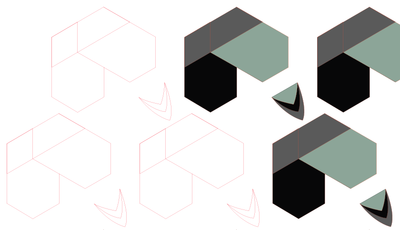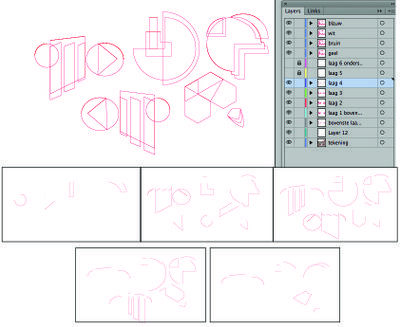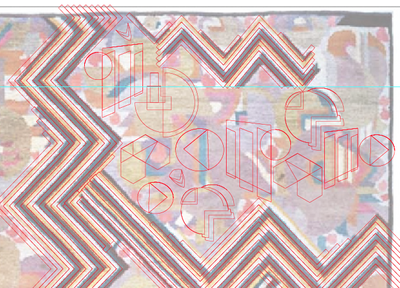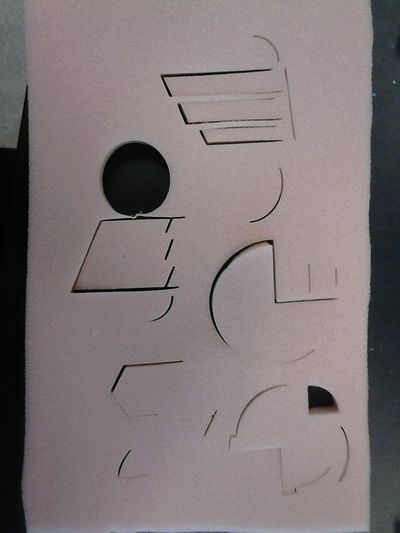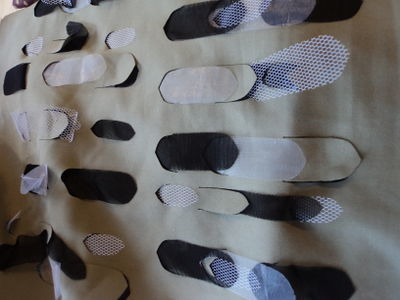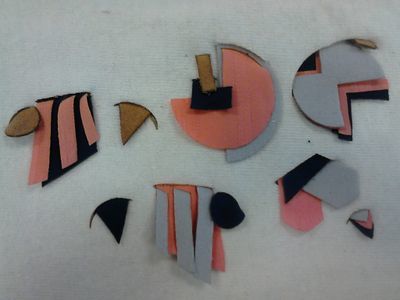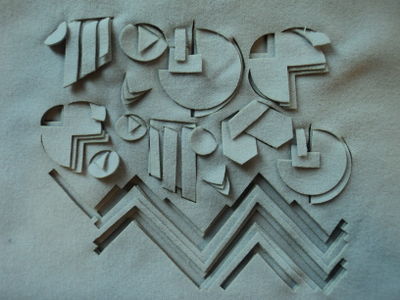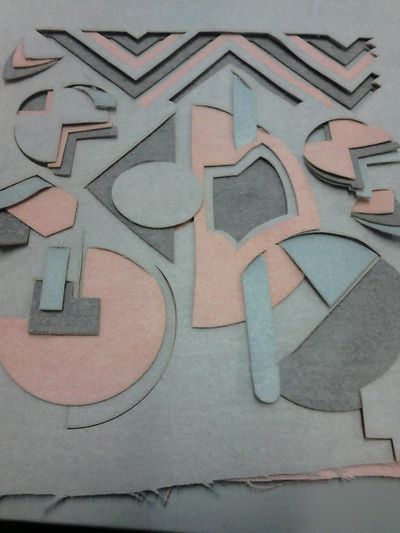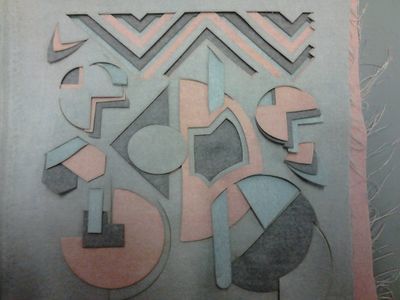User:0860816
Contents
Lizet van der knaap. Opleiding Mode
✄-------------
Stealing from the museum
Project week: Joeke, Remy, Denise en ik
Fantastic Forgeries
Fantastic Forgeries presents alternate histories of Dutch material culture through the research and evaluation of existing artefacts – and their appropriation, transformation and remaking. Fantastic Forgeries uses historical crafted objects as a departure point to reflect on the status and practice of craft in our contemporary society. The objects will be used as tools to examine traditional ways of making as well as a formal, tactile, and decorative inspiration to compare when stretching the boundaries of (artisanal/digital) fabrication.

Albert Van huffel, Gezusters De Saedeleer, Etikhove, Vloerkleed Mer (Zee), 1926 . Wol. 294 x 233 cm
The interest I have in carpets caused by the material, colour, technique, history and especially the prints. Each carpet has its own story. The colour and design can tell you where the carpet comes from and from which culture it originated.
Carpets can be produced on a loom quite similar to woven fabric, made using needle felts, knotted by hand (in oriental rugs), made with their pile injected into a backing material (called tufting), flatwoven, made by hooking wool or cotton through the meshes of a sturdy fabric or embroidered.
Different types of carpets
Woven
The carpet is produced on a loom quite similar to woven fabric. The pile can be plush(1) or Berber(2). Plush carpet is a cut pile and Berber carpet is a loop pile. There are new styles of carpet combining the two styles called cut and loop carpeting. Normally many colored yarns are used and this process is capable of producing intricate patterns from predetermined designs (although some limitations apply to certain weaving methods with regard to accuracy of pattern within the carpet). These carpets are usually the most expensive due to the relatively slow speed of the manufacturing process. These are very famous in India, Pakistan and Arabia.
https://www.youtube.com/watch?v=COBVGMEu2Zw
A closeup look at the Navajo rug weavers
(1)plush
Originally the pile of plush consisted of mohair or worsted yarn, but now silk by itself or with a cotton backing is used for plush.
(2)Berber
Made by Berbers in North Africa. Modern Berber carpet made from a wide variety of materials, Nylon, Olefin fiber, and wool.
Needle felt
These carpets are more technologically advanced. Needle felts are produced by intermingling and felting individual synthetic fibers using barbed and forked needles forming an extremely durable carpet. These carpets are normally found in commercial settings such as hotels and restaurants where there is frequent traffic.
https://www.youtube.com/watch?v=OO4JlEdubAQ
a needle felt machine
Knotted
On a knotted pile carpet (formally, a supplementary weft cut-loop pile carpet), the structural weft threads alternate with a supplementary weft that rises at right angles to the surface of the weave. This supplementary weft is attached to the warp by one of three knot types, such as shag carpet which was popular in the 1970s, to form the pile or nap of the carpet. Knotting by hand is most prevalent in oriental rugs and carpets. Kashmir carpets are also hand-knotted.
https://www.youtube.com/watch?v=oJO3N8wiE_A
technique of the knot
Tufted
These are carpets that have their pile injected into a backing material, which is itself then bonded to a secondary backing made of a woven hessian weave or a man made alternative to provide stability. The pile is often sheared in order to achieve different textures. This is the most common method of manufacturing of domestic carpets for floor covering purposes in the world.
https://www.youtube.com/watch?v=fO3-EmCTknc
Making of Hand Tufted Carpets
flatweave carpet
A flatweave carpet is created by interlocking warp (vertical) and weft (horizontal) threads. Types of oriental flatwoven carpet include kilim, soumak, plain weave, and tapestry weave. Types of European flatwoven carpets include Venetian, Dutch, damask, list, haircloth, and ingrain (aka double cloth, two-ply, triple cloth, or three-ply).
https://www.youtube.com/watch?v=PTJ918L-pro
flatweave technique
hooked rug
A hooked rug is a simple type of rug handmade by pulling strips of cloth such as wool or cotton through the meshes of a sturdy fabric such as burlap. This type of rug is now generally made as a handicraft.
https://www.youtube.com/watch?v=dFkqnT8Czng
hooked rug technique
Twinning
Twinning is a method of combining two fabrics onto one rug
https://www.youtube.com/watch?v=ZWQqUsGGphk
twinning technique
My Replica
To make a replica i want to know as much as possible about the carpet of Albert van Huffel. This was a little disappointing because there is not so much information about his carpets because he is more famous as an architect. But i looked up some information where the carpet is made and send an email to the factory who made the carpet in this time. I asked if they have more information for me.
I would like to create a copy of this carpet by using the graphic print. I want to replace the material and technique. The similarity between old carpets is that they are often woven. My goal is to copy it to another rug weaving technique which I develop myself through technology. I will also, where possible, use other materials. If i can I will use natural materials to dye them and try to create the same colour.
Vloerkleed Albert Van huffel
In 1925-1926 ontwerpt architect Albert Van huffel de woning voor aannemer Bruxelman in Ledeberg Gent. Naar goede gewoonte staat hij ook in voor de vormgeving van interieur en meubilair. Van huffel vertrouwt de uitvoering van de vloerkleden toe aan Elisabeth De Saedeleer, een collega aan de kunsthogeschool La Cambre. Zij leidt in Etikhove een ambachtelijke tapijtweverij en -knoperij. Hier laat Van huffel zich vaak van zijn meest exuberante zijde zien. Een fel bewogen ritmiek van geometrische zigzagmotieven in strek contrasterende kleuren maakt het textiel tot een bewogen zee. (bron: Design Derby boek)
because i can't found so much information about Albert i look up information who actually made the carpet and look if she has an own technique to make carpets.
Elisabeth De Saedeleer Via de dochter van William Morris, bezieler van de Engelse Arts en Crafts Movement (Kunst- en Kunstambachtenbeweging), konden de oudste dochters een opleiding volgen in de handweefkunst bij gerenommeerde wevers uit de streek. Naast haar zussen Marie-Josepha en Monica bleek vooral Elisabeth De Saedeleer zeer begaafd. Na zekere tijd kregen zij allerlei opdrachten, en bouwden zij een zekere reputatie op, terwijl vader Valerius, naast zijn schilderkunst, ook de zakelijke zijde van het weven op zich nam. Door omstandigheden is de familie niet in Wales gebleven, maar keerden zij naar Vlaanderen terug om zich in 1921 te Etikhove te vestigen. Begin 1925 gingen de gebroeders Luc en Paul Haesaerts, neergestreken in “Auberge De Vos” op het dorpsplein, zich associëren met de gezusters De Saedeleer onder de naam “Société de Tapis d’Art De Saedeleer et Co”, ook wel “Studio De Saedeleer” genoemd.
During the 1920' and '30s the studio of Elisabeth de Saedeleer was especially known for making knotted floor coverings (Bron: Kleur voor wand en vloer. Hetwee/atelier Elisabeth de Saedeleer (1902-1972), 0udenaaIde: Stadhuis Lakenhalle, 1993.)
In 1947 de Saedeleer published the book "The Art of Hand Weaving" 8. Beside the materials, the spinning, the dying and the weaving, she described several weaving techniques and speaks about carpet weaving and making tapestries.(bron: A second edition was published after her death: De Saedeleer, Elisabeth, De handweejkunst, Brussel, 1974.) (http://digitalcommons.unl.edu/cgi/viewcontent.cgi?article=1177&context=tsaconf)
--boek-- De kunst van het tapijt weven is ontstaan in het oosten, waarschijnlijk in Perzië naar de gebruikte motieven te oordelen. Tot nu toe heeft men niet kunnen vaststellen in welk tijdperk de eerste tapijten vervaardigd werken. Het weven werd door vrouwen beoefend en alleen voor eigen gebruikt. Het ontwerp werk in grootte trekken op den grond getekend, de wol volgens kleur gerangschikt en het aantal knopen berekend. Ornament en kleur hadden een symbolische betekening en iedere volksstam had zijn eigen zinnebeelden. Het geknoopte tapijt als vloerbedekking werk op getouwen met staande ketting vervaardigd. De wollen inslagdraden werden op den ketting geknoopt en later gelijk geknopt om een effen bovenvlak te verkrijgen. Blz 79
De werk tekening
Al de elementen van het patroon worden grafisch voorgesteld, door middel van kleuren en tekens, op speciaal ruitjespapier. De vakjes van dit papier, die gekleurd worden, geven den omtrek of den vorm van het patroon weer en zijn steken in het werk. De meer geaccentueerde lijnen verdelen het blad ruitjespapier in vierkanten. Zo’n vierkant noemt men een tiental, zonder rekening te houden het aantal vakjes. Elk blad ruitjespapier bevat hoogstens 10 tot 20 vierkanten, daarom is het nodig verschillende balden aan een te plakken, waarbij de lijnen juist overeen moeten komen. Bij het optekenen volgt het patroon de ruitjes, zodat een golflijn trapvorming verloopt. De krommingen moeten echter zo nauwkeurig mogelijk gevold worden, want de geriste afwijking schaadt aan het uitzicht van het werk. Het is echter meestal niet mogelijk al de details van het ontwerp getrouw weer te geven en tijdens het werk zullen aanpassingen nodig blijken.
Bron: de handweefkunst door Elisabeth de seadeleer blz 90-91
Het knopen
Door de inleg van knopen ontstaat het mollig, pluche-achtige vlak van het tapijt. De manier waarop de knopen gelegd worden en de lengte der pluizen kunnen verschillen. Een knoop wordt over twee kettingdraden gelegd met een bijzondere inslag van zogezegde pooldraden.
De Shena-knopp wordt gelegd zoals op de tekening staat aangeduid deze haaktoer vormt geen echte knoop, maar de pooldraden zijn daartegen regelmatig verdeeld, namelijk een pooldraad voor elke kettingdraad. Hierdoor komt de tekening beter tot haar recht en bedekt volledig het grondweefsel.
De Ghiordes-knoop vormt wel een echten knoop, zoals op de tekening te zien is, maar het leggen gaat niet zo vlug en verbruikt meer wol. Voor de zelfkanten moet deze manier van knopen echter noodzakelijk toegepast worden. De knopen worden met een lus om de mesvormige staaf gelegd, waarmede de lussen opgesneden worden voor het vormen der pluizen.
What is your craft
1 What is your craft? (define your discipline, method or approach)
I choose the carpet of Albert van Huffel. The technique they used for the carpet is a Persian knot. It means that it’s knotted and al the knots are woven into each other. My craft for this project is to search for a new woven/knotting technique. I want to do this by using fabric instead of wires, which they normally use in carpets. I want to use the laser cutter to realize this. My goal is to create the carpet with the graphic prints into layers of fabric in order to create a 3D effect and no flat print. I don’t want to use the sewing machine I only want to weave and knot the fabric into each other.
2 What are the tools and media of your craft?
I wan to use different layers of fabric to create a 3D effect with the print. I will use the laser cutter to cut out forms and folding lines. The laser cutter is a perfect tool for me. It will burn out the form whereby at the same time the edges would be finished, so I don’t need to make a finishing in the fabric with the machine. I have to use a fabric that has polyester or some plastic substance in it, the polyester with melt that the fabric has no change to fray
3 What are the borders of this practice? (what new media
technologies have arisen / what is its future of the field))
My challenge in this project is to create a print whereby I have to really think about where to make cuts, and how to weave the forms together. I must make sure that the print will not be flat but really creates a 3D effect. I want to do this that I can use it to make garments with it. It’s a new method that I haven't seen in the fashion industry before.

